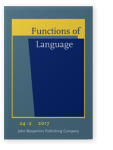Vol. 24:2 (2017) ► pp.139–165
The modification of compound nouns by three adjectives
This paper is the final instalment in a series of studies investigating the modification patterns in complex noun phrases (NPs) in English. It particularly focuses on the modification of two-noun compounds by three attributive adjectives. An analysis of all such NPs from the BNC reveals a strong preference for head modification over modifier modification, similar rates of convergent and divergent modification and the non-occurrence of crossed modification. The single most important factor influencing the modification patterns is functional status. The larger the number of adjectives modifying the head of the compound, the higher the frequency of the modification type (modulo a proximity effect). The absence of crossed modification is expected under the no-crossing constraint, which is understood here not as a formal but as a functional principle ensuring successful communication. The various factors can be tied together under the rubric of accessibility. The probability of selecting a particular modification target is argued to be a function of the accessibility of the nouns in an NP.
Article outline
- 1.Introduction
- 2.Survey of logically possible modification types
- 3.Predictions
- 4.Data sampling
- 5.Data analysis
- 5.1An analysis of triple-adjective NPs
- 5.2Comparison with double-adjective NPs
- 6.Theoretical discussion
- 6.1Function and proximity
- 6.2The no-crossing constraint
- 6.3The communicative perspective
- 7.Ever more complex cases
- 8.Conclusion
- Acknowledgements
- Notes
-
References
This article is currently available as a sample article.
